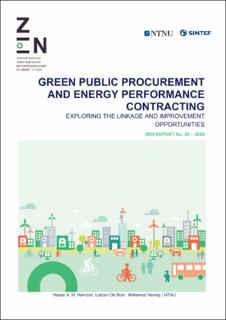| dc.description.abstract | Energy Performance Contracting (EPC) is a method to finance energy efficiency investments from cost savings in the building sector. Under an EPC arrangement, an external organization, an Energy Service Company (ESCO), initiates a project to achieve energy efficiency in a building. It uses the stream of income from the cost savings to repay their investments. ESCOs and EPC are a desirable mechanism to capture cost-effective energy-efficiency potentials with the private sector’s involvement.
In public projects, public procurement and green public procurement are the carrying vehicles of EPC where public clients use public procurement procedures and functionalities to select the right ESCO before landing on a suitable EPC agreement. In other words, public procurement is a prerequisite to EPC in public building projects. Though EPC has received much attention in the building sector and can probably be considered among the most effective mechanisms for energy efficiency in the public sector, very few studies have looked at EPC from a public procurement perspective. The current report aims to explore the link between green public procurement (GPP) and energy performance contracting (EPC) and propose improvement opportunities for EPC capitalizing on knowledge and practices derived from GPP.
In the current report, we discuss an approach to improve EPC presence in the public and residential sectors. That is, capitalizing on GPP practices, using bundling and scaling up strategies, and managing complexity. First, anchoring EPC projects in GPP will generally improve the project’s environmental performance and ensure the selection of a qualified ESCO, especially since Norway is in an advanced position when it comes to implementing green solutions in public expenditures. Seeing EPC projects as part of the broader public procurement system may bring benefits to EPC’s future in Norway. As a result, positioning EPCs as GPPs will not only benefit the EPCs, by may also lead to an increase in the awareness and acceptance of ESCOs among public and private clients. Second, pooling or bundling renovation efforts into larger blocks can be conducive to benefit from economies of scale. More extensive projects could be used to attract ESCOs in smaller municipalities. Lastly, managing complexity in EPC projects might translate to better collaboration between the involved parties. In other words, knowing when and where to let complexity emerge could probably improve collaboration throughout the stages of EPC projects. | |
